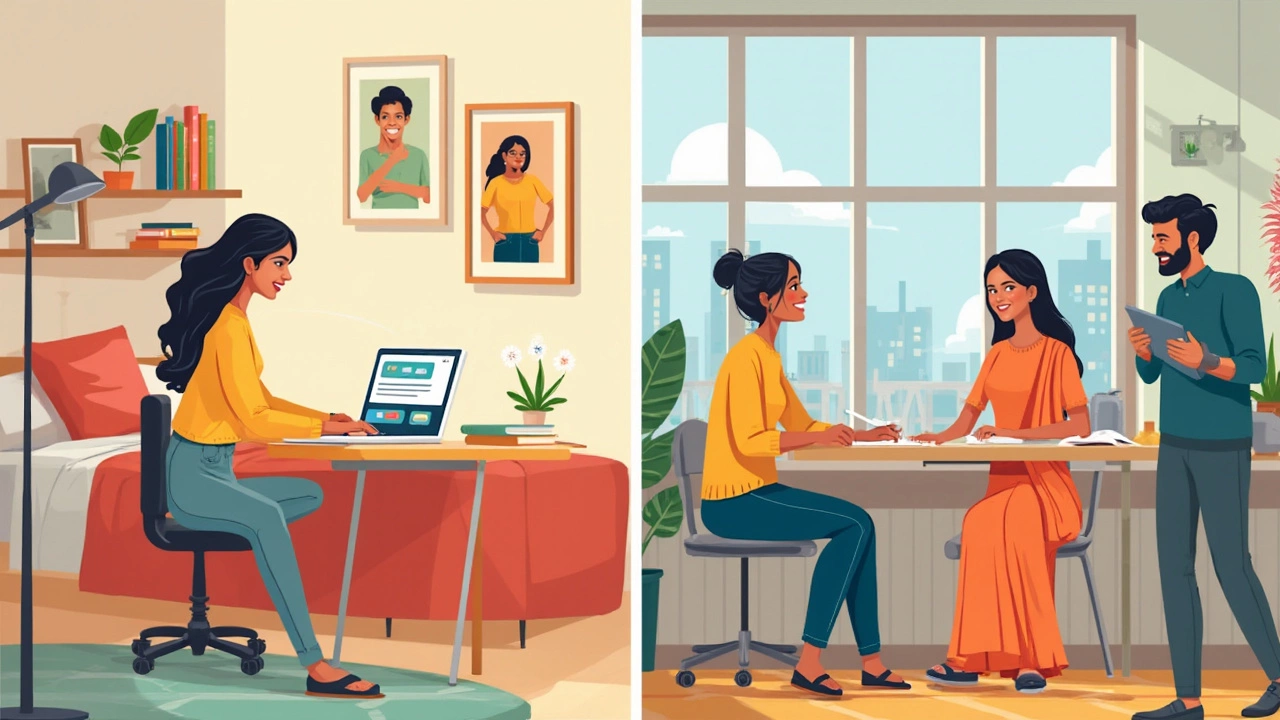If you picture a classroom, you probably see rows of desks, a teacher with a whiteboard, and students shuffling papers. That's traditional education for you—face-to-face learning in a set place, usually on a fixed schedule. Now fast-forward to distance education. Here, you’re just as likely to be learning in your pajamas, with a laptop on your couch, while lectures stream from halfway across the world. The main thing? Distance education cuts out the need to be in a physical classroom at a certain time.
This change flips the whole idea of what 'going to school' looks like. Instead of spending hours commuting, you can dive into lessons whenever you have time—early in the morning or even after work. No more stressing about missing the bus. That's a lifesaver for parents, people juggling jobs, or anyone who hates the 8 a.m. rush. Still, learning from home means you're in charge of keeping yourself on track. Sounds great, but if you need someone breathing down your neck to finish an assignment, it’s worth thinking about whether distance education fits your personality.
- Learning Environment and Flexibility
- Interaction and Communication
- Assessment and Feedback
- Tips for Choosing What Works for You
Learning Environment and Flexibility
Traditional education locks you into a set routine. Classes are scheduled at specific times. Professors expect you to show up, be ready, and participate in person. The environment is controlled—think fixed rows of desks, group work in the classroom, and everything happening on campus. If you thrive on face-to-face interaction and a regular schedule, this setup can feel right.
But what if life doesn’t fit into perfect blocks of time? That’s where distance education flips the script. There’s no physical classroom, just a digital space you can access from anywhere—your bedroom, a coffee shop, or even a different country. Lectures are often recorded, study resources are up online, and assignments get posted to learning platforms. Instead of planning your life around school, school bends around your life.
- You can learn at your own pace—pause a video, rewind tricky bits, or rush through material you already know.
- Time zones stop being an issue. Want to learn from a university abroad without moving there? Distance options make it possible.
- Need to work or take care of family? Juggling becomes easier, since you can slot lessons into your free time.
One big tradeoff: nobody’s looking over your shoulder. That freedom sounds amazing, but it takes real self-discipline—procrastinators, you’ve been warned. Studies by the National Center for Education Statistics show that online students value this flexibility, especially adults coming back to study or those balancing work and school.
If your life is packed or unpredictable, this flexible environment can mean the difference between earning a qualification or dropping out. Ask yourself what fits your personality—do you need a bit of structure, or do you want to take the wheel?
Interaction and Communication
Traditional classrooms put you in the same room as teachers and classmates, which makes chatting or asking questions feel really natural. Just raise your hand and start talking. There’s eye contact, quick feedback, and even those off-topic conversations that somehow make class more fun. You end up with friendships just from hanging out between classes or grabbing lunch together.
Now, with distance education, all the interaction usually happens through screens—think email, discussion boards, video calls, or instant messaging apps. Group projects don’t go away, but now you’re coordinating over Zoom or WhatsApp instead of arguing over who gets the easiest part in person. One study from 2023 found that 65% of distance learners missed face-to-face banter but liked having more time to think before replying online, so it’s not all bad—introverts, for example, can thrive here because they can participate without feeling put on the spot.
Tech tools shape the way people connect remotely. Universities often use platforms like Canvas, Blackboard, or Google Classroom to post assignments, grades, and feedback. If you're ever stuck, you’ll probably email your teacher or jump into a tutor’s virtual office hours. It’s not instant, though—sometimes you wait hours, or even until the next day, for a reply. Here’s a quick breakdown:
| Method | Traditional Education | Distance Education |
|---|---|---|
| Questions to Teachers | Instant, face-to-face | Email, chat, waiting for a reply |
| Peer Group Work | In-person meetings, easy coordination | Online meetings, more planning |
| Getting Feedback | Right away in class | May be delayed |
| Building Friendships | Coffee breaks, campus life | Online communities, social media |
Want a tip? If you’re thinking about distance education, join class forums and group chats early. Introduce yourself and don’t wait until you need help to start talking. People who are active online tend to feel less isolated—which really matters if you miss those between-class conversations from campus life.

Assessment and Feedback
This is where people really notice the gap between distance education and traditional classes. In a normal classroom, you get feedback right as it happens—raise your hand, and the teacher responds. With distance education, it's a different story. Most quizzes and assignments are handled online. Automated systems often grade your work instantly, especially for things like multiple choice exams. It’s quick, but sometimes it feels one-size-fits-all.
For more complex stuff—like essays or projects—real teachers still grade, but the feedback comes through email or learning platforms. This can be cool because you get written notes you can go back to, but you might miss that personal, in-the-moment talk. And if you’re stuck, waiting for a reply can get frustrating.
- Traditional classes usually hand out physical papers, with handwritten notes in the margins.
- Distance education often uses rubrics and typed comments, which means you can keep an organized digital record of your feedback.
- Some online platforms let you get instant feedback from quizzes, helping you spot what you know (and don't!) right away.
- Expect video feedback to pop up more in online schools, but live face-to-face feedback is still rare unless your course uses live sessions.
According to the 2023 Online Learning Consortium report, "more than 60% of online students appreciated getting quicker feedback through automated systems, but about half wanted more chances for live discussion with their instructors."
"The speed of online assessment is great, but nothing beats a real conversation when you’re trying to learn from mistakes," says Dr. Amanda Bennett, a researcher in digital education at the University of Michigan.
So, when choosing your style, think about how much feedback you need and how fast you like to get it. If you value back-and-forth chats, traditional might click better. If written notes you can revisit help you more, then distance fits the bill.
Tips for Choosing What Works for You
Picking between campus classes and distance education isn't just about where you sit. It's about how you learn, what keeps you motivated, and what fits your life. Here’s what to weigh up if you’re on the fence.
- Check your schedule: If you’ve got a full-time job, family commitments, or just hate the idea of being tied down to a strict class timetable, online courses might be your best bet. A 2023 survey by EducationData.org found that 71% of adult learners preferred online programs just because they could juggle them easily with work.
- Think about your learning style: If you get more out of real-life discussions, group projects, and a clearly structured day, a traditional classroom might be better. Online classes can be isolating — about 28% of online students report missing regular face-to-face contact and support from teachers, according to a 2024 US college study.
- Tech comfort level: If the idea of troubleshooting tech issues makes you want to scream, in-person classes will probably be less stressful. But if you love using new apps, online platforms, and you’re cool with sorting out Wi-Fi glitches, distance learning is made for you.
- Career goals: Some jobs or licenses still want hands-on practice or recognized face-to-face time (like nursing or engineering). Double-check what your future employer expects before you sign up for a program.
Want to see a side-by-side quick comparison? Check out how both stack up on major factors:
| Factor | Traditional Education | Distance Education |
|---|---|---|
| Flexibility | Low | High |
| Cost (average US undergrad, 2024) | $10,940/year | $6,840/year |
| Average commute | 25 min/day | 0 min |
| Face-to-face interaction | High | Low |
| Tech requirement | Low | High |
| Self-motivation needed | Moderate | High |
If you’re still unsure, try a free online course from a legit provider. See if you can keep up on your own. There’s no shame in figuring out what actually works for you — the right pick could mean the difference between struggling and thriving.
